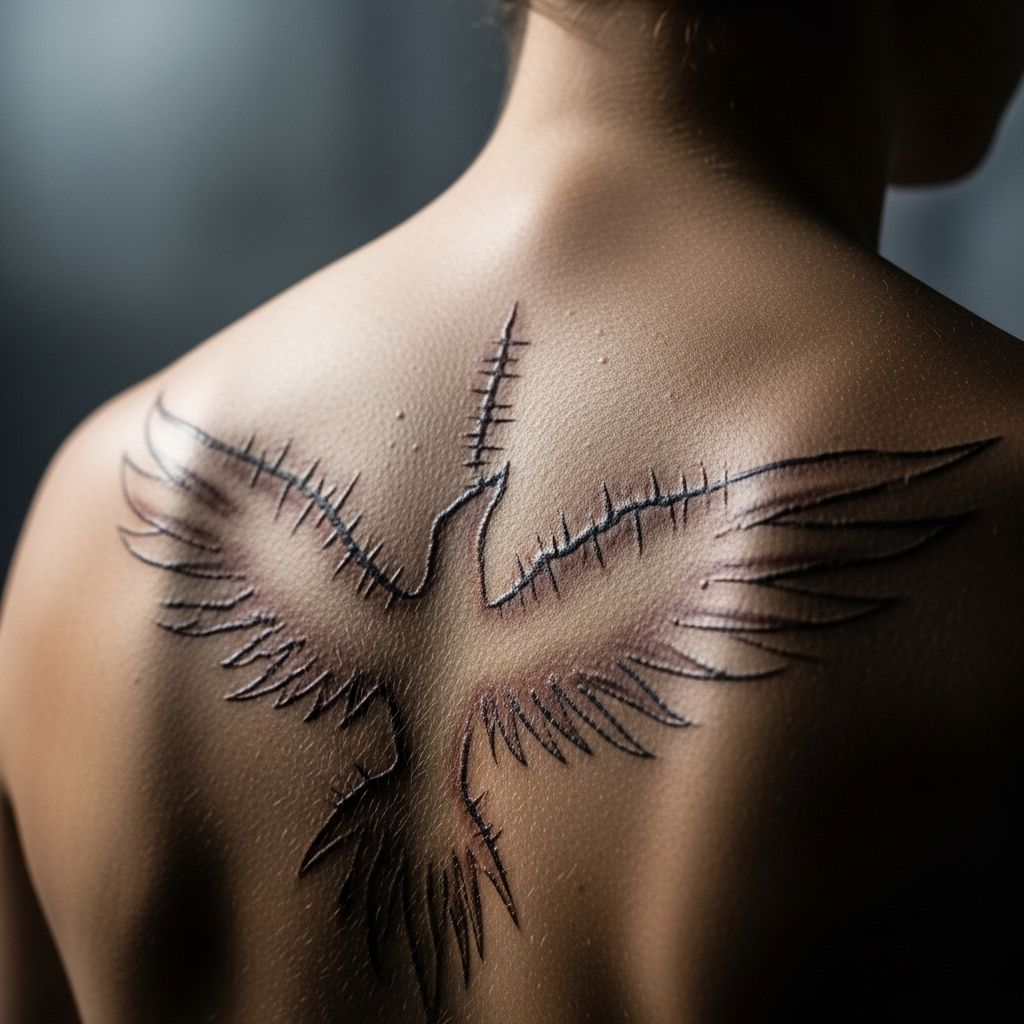Branded: The Tattooed Scars and Resilience of Sex Trafficking Survivors
Uncover the harrowing reality of branding in sex trafficking—and the courageous journeys of survivors reclaiming their selfhood.

Branded for Control: How Sex Traffickers Use Tattoos to Mark Ownership
For countless survivors of sex trafficking, the trauma does not end when exploitation stops. Tattoos and other forms of branding—often forcibly applied by traffickers—leave lasting physical reminders of abuse, control, and lost autonomy. These marks symbolize ownership, often designed as a visible ‘claim’ over an individual, and can be as overt as a trafficker’s name, gang symbols, barcodes, or threatening phrases. Branding is both a psychological tool and a practical tactic to instill fear, suppress escape, and reinforce a trafficker’s dominance over the victim.
According to survivors, tattoos commonly serve as a constant reminder—a visual reinforcement of trauma and subjugation that persists long after escape. Experts highlight that branding through tattoos is analogous to marking livestock, aiming to dehumanize victims and make their escape seem impossible.
Common Branding Methods
- Names & Initials: Traffickers often tattoo their own names, initials, or nicknames directly onto victims’ bodies, typically in highly visible locations such as the neck, chest, or wrists.
- Symbols & Logos: Some use unique symbols, pictograms, or gang emblems to label victims as property or align them with a trafficking network.
- Phrases & Numbers: Branding can include coded phrases, numbers signifying order within a group, or even barcodes signifying identification or sale value.
- Matching Tattoos: Victims trafficked by the same individual sometimes receive identical tattoo designs, further reinforcing group identity and outsider status.
Survivor Stories: Breaking Free and Reclaiming Identity
Escaping trafficking is never easy, and for many survivors, removing or covering branding tattoos marks a critical turning point toward healing. Molly, for example, endured sex trafficking from the age of 21, ultimately finding support through organizations like Verity that helped her remove the tattoos forced upon her by her trafficker—a step she describes as essential not only to her physical recovery but also to her sense of self-worth and hope for the future.
Stories like Molly’s are echoed across the country. Many survivors report that branded tattoos serve as painful reminders, impeding their ability to move forward and causing difficulty in accessing employment, housing, and relationships. Tattoo removal services, covering solutions, and advocacy networks have become lifelines, offering survivors a means to reclaim ownership of their bodies and redefine their identities outside the shadow of exploitation.
Healing through Tattoo Removal and Cover-Ups
For many, the process of erasing branded tattoos is transformative. A survivor named Natalie Grace emphasized the psychological shift after removing tear-shaped tattoos her trafficker had put on her face, explaining, “I want them completely removed. I’ve always been a professional, and I want to be back to my old professional self. This is not me. This is not what I was meant to do. It’s time to wipe my tears.”
- Laser Removal: The gold standard, but not always possible for deep or extensive tattoos.
- Cover-Up Tattoos: An alternative where removal is impractical; survivors choose new artwork to symbolize freedom and healing, often with deeply personal significance.
- Symbolic Renewal: Examples include transforming a burn scar inflicted by a trafficker into a cross and the names of one’s children, or replacing a trafficker’s mark with flowers and butterflies to signify rebirth and hope.
The Psychological Impact of Branding and Recovery
The emotional ramifications of branding are profound. Survivors cite feelings of shame, loss of agency, and constant reminders of past abuse. Removal or transformation of these marks often delivers a powerful cathartic effect, scoring as high as 9.2 out of 10 for impact on recovery in one study.
Jennifer Kempton, a well-known survivor, noted the emotional lift after covering her branding: “Knowing that when I walked out the door I’d have replaced that sign of evil with something that was beautiful and full of life and hope: I knew I was going to set myself free, and man, that was a great feeling.”
Challenges Faced by Survivors
- Stigmatization: Tattoos linked to trafficking can mark survivors as untrustworthy to employers, landlords, and even social service providers.
- Re-Traumatization: Police or investigators unfamiliar with the markers may misinterpret their significance, causing further questioning or disbelief.
- Difficulty in Covering Costs: Many survivors struggle to afford tattoo removal, leading nonprofits and volunteer networks to step in.
- Limited Access: Tattoo removal is not available everywhere, and survivors may face waiting lists or transportation barriers.
Support Networks: Removing Marks and Restoring Dignity
A number of organizations have emerged to provide survivors with access to tattoo removal and cover-up services:
- Verity: Supports survivors with free tattoo removal, financial aid, and personal advocacy.
- Soul Survivor Ink: Sees up to 1,500 survivors a year and provides cover-ups or laser removal, letting survivors choose new designs that reflect reclamation and hope.
- The Exodus Road: Helps fund and coordinate removal for survivors internationally, moving them beyond physical reminders of exploitation.
- Local Tattoo Artists: Increasingly offer free or discounted cover-ups for survivors, prioritizing designs chosen by the survivors themselves to ensure personal agency is honored.
Freedom Walls and Community Healing
Some organizations maintain Freedom Walls, where survivors leave handprints or messages signifying their escape and new beginnings. Marking the completion of the tattoo removal or cover-up process symbolizes the end of a traumatic chapter and the start of a new journey. One advocate refers to these ceremonies as lifting a weight off survivors’ shoulders—an important but not total fix for what they see in the mirror.
Dispelling Myths: Tattoos, Consent, and Identity
While tattoos remain popular and often empowering for millions, their role in sex trafficking reveals stark contrasts. Tattooing within the context of exploitation is not a matter of personal choice but a strategy of coercion and manipulation. Debunking the myth that all tattoos signify personal expression is crucial for understanding, identifying, and assisting trafficking victims:
- Not All Tattoos Are Chosen: Survivors explain how branding is about power, punishment, and isolation, not beauty or self-expression.
- Invisible Scars Remain: Even after removal or transformation, emotional scars require ongoing support and therapy.
- Complex Investigations: In some cases, unique tattoo designs have helped law enforcement identify networks and connect survivors to cases that would otherwise go unreported.
The Vital Role of Advocacy and Education
Awareness and early intervention can change, and sometimes save, lives. Organizations and practitioners increasingly train hospital staff, police, social workers, and tattoo artists to recognize branding tattoos as red flags for trafficking. Survivors, once silenced or misunderstood, now serve as leaders, consultants, and educators—but note that full recovery hinges on comprehensive, trauma-informed care and respect for survivors’ autonomy throughout the healing process.
What You Can Do
- Support local or national groups dedicated to survivor assistance.
- Learn to identify trafficking-related tattoos and report suspicions to authorities compassionately.
- Share survivors’ stories—amplifying their voices to destigmatize and advocate for widespread support.
- Advocate for increased funding to expand tattoo removal and psychological services.
Frequently Asked Questions (FAQs)
Q: What kinds of tattoos are common in sex trafficking branding?
A: Names, initials, unique symbols, coded phrases, gang logos, and matching designs among groups of victims are most commonly reported. These are intentionally placed in visible locations to mark the victim as someone’s property and to reinforce group identity.
Q: Why do traffickers use tattoos for branding?
A: Tattoos are used as a tool of psychological control. Branding instills fear and signals ownership, helping traffickers intimidate their victims and discourage escape. It can also serve as a warning to others and make leaving or starting over more difficult.
Q: Can branding tattoos be removed?
A: Removal is possible through laser treatment, but not always practical for all types of tattoos. Cover-up tattoos are common alternatives, allowing survivors to reclaim the site with new artwork of their own choosing.
Q: Is tattoo removal important to survivors’ recovery?
A: Yes. Studies and survivor testimony show tattoo removal or cover-ups can be transformative, marking a critical step in emotional healing and restoration of self-esteem.
Q: How can the public help trafficking survivors?
A: Support nonprofit organizations that provide removal services, educate yourself and others about branding, look out for signs that may indicate exploitation, and amplify survivor voices to promote broader understanding and compassion.
Critical Steps Forward: Dignity, Agency, and Community Support
The journey from exploitation to empowerment is marked by acts of courage, community support, and small but deeply meaningful victories. Removing or transforming a branding tattoo, while not erasing years of pain, provides survivors with a visual and emotional break from their past and the autonomy to determine their future. As awareness grows, so too does hope that every survivor can one day look in the mirror—and see themselves free from marks of ownership, defined only by their own choices and dreams.
References
- https://www.ourverity.org/blog/rising-above-a-human-trafficking-survivors-powerful-message-of-hope
- https://theexodusroad.com/human-trafficking-and-tattoos/
- https://www.youtube.com/watch?v=xxzXUQtnDtM
- https://surviveandthriveadvocacy.org/former-gang-members-trafficking-victims-escape-dangerous-past-with-free-branding-tattoo-removal/
- https://ourrescue.org/education/prevention-awareness/how-do-human-traffickers-mark-their-victims
Read full bio of Sneha Tete












